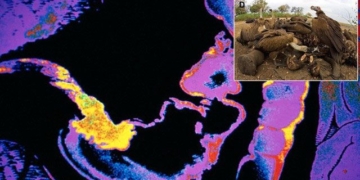The world that NASA’s life-hunting spacecraft will target in 2024 continues to reveal fascinating details.
During a flyby of the “ocean moon” Europa, the Juno spacecraft exploring Jupiter has captured potential hints of ongoing surface activity on this celestial body.
Specifically, images from a specialized camera known as the SRU on Juno show a strangely shaped icy area.

Jupiter’s ocean moon Europa with the Europa Clipper spacecraft expected to fly above in the future – (Graphic image: NASA).
This area, measuring 37×67 km, resembles a giant platypus, with the body in the north and the bill in the south. The two regions are connected by a narrow strip containing large ice blocks, each approximately 1 km in size and casting shadows.
Notably, these images show significant differences in the southern region compared to images Juno captured between 1995 and 2003.
If Europa’s surface is indeed changing, it represents a very important finding. In our Solar System, only Earth and Jupiter’s moon Io are known to have geological activity.
While Io is overwhelmed by volcanic activity, making its geological activity excessive, the moderate geological activity on Earth contributes to the existence and evolution of life, relating to stability in the lithosphere, atmosphere, and aiding in the chemical balance of habitats.
If Europa also has surface geological activity, the prospects for its habitability increase significantly.
However, the authors from NASA’s Jet Propulsion Laboratory (JPL) argue that the evidence from Juno is still weak due to the quality of images showing some differences during the phases.
Therefore, it cannot yet be concluded that Europa has surface activity. It remains just a suggestion, awaiting clarification from the Europa Clipper. This life-hunting warrior is scheduled for launch by NASA in October 2024 and will focus on Europa instead of just conducting a general exploration of Jupiter and its moons.
Additionally, these intriguing images provide many interesting details suggesting that this is indeed where the Europa Clipper should concentrate: They include sediments that may relate to liquid water just beneath the surface, as well as water-laden plumes being ejected.
Previously, a series of evidence suggesting the possibility of life has been identified on Europa, making it one of NASA’s top priorities for searching for extraterrestrial life.


















































